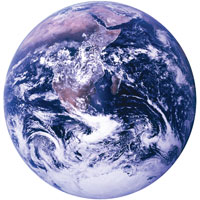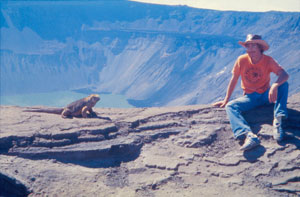
Home
Earth's Fastest Spreading Ridge
Hawaii Institute of Geophysics and Planetology
Dr. Richard N. Hey
Hey received his B.S. from Caltech in 1969, eventually majoring in Geology for many reasons, including the fieldtrips, Bob Sharp's teaching, a linear algebra class required for math majors, and possibly the sudden emergence of the San Gabriel Mountains a few days after he arrived in Pasadena. He began his graduate work at Princeton with Harry Hess, got advice about seafloor spreading analysis from Fred Vine, and learned to teach from Ken Deffeyes, but mostly was fortunate enough to arrive at Princeton two years after Jason Morgan discovered plate tectonics and to become Jason's first plate tectonics grad student, an outstanding example of being in the right place at the right time. His Geology and Geophysics Ph.D. work used triple junction geometry to analyze plate motions in the East Pacific, and showed that the seemingly fatal geometrical objections to the hotspot hypothesis in the Galapagos area could be resolved if small ridge jumps toward the hotspot had produced asymmetric accretion. This work established Galapagos as a hotspot and showed how the area evolved since the Farallon plate broke apart to form the Cocos and Nazca plates, suggesting that evolution producing the “peculiar organic beings” there had been considerably faster than Darwin and others had thought.
Doc Ewing gave him his first real job, at the University of Texas Marine Science Institute in Galveston, where he showed the Galapagos ridge jumps occurred in systematic patterns, which led him to the propagating rift hypothesis for how the Earth's accretional plate boundary geometry is reorganized. Moving to the University of Hawaii, he initiated the Marine Magnetics Lab, which included Clyde Nishimura, Doug Wilson, and young Jason (later Phipps) Morgan, as well as the Crack of Noon film production company, also involving Fred Duennebier and Grant Blackinton. This work, mostly in the Galapagos and Juan de Fuca areas, and including computer graphics animation movies, showed the importance of hotspot-ridge interactions and made the propagating rift hypothesis a well-established part of plate tectonic theory, with significant petrologic implications mostly worked out by John Sinton and Dave Christie.
Moving to the Scripps Institution of Oceanography, he directed the Plate Tectonics Lab from 1981-1986. This lab included grad students Marty Kleinrock, David Naar, and Dave Caress, programmer Mike Keeler, student help/secretary Andra Bobbitt, and Bill Menard after he returned from the USGS, as well as Tom Jordan and John Orcutt at lunch on Fridays. These were also very productive years, with numerous oceanographic expeditions using state of the art equipment including SeaBeam, SeaMARC II, GLORIA, Deep-Tow, and ALVIN, leading to important advances in understanding Galapagos rift propagation and the anomalous Easter Microplate area, as well as changes in direction of seafloor spreading and evolution of the great Pacific fracture zones.
Since 1986 he has been teaching and doing research at the University of Hawaii, where he currently teaches Plate Tectonics, ERTH/OCN 444. His recent students and postdocs have included Laurie Skaer Fernandez, Fernando Martinez, the other Paul Johnson, Debbie Pardee and Ásdís Benediktsdóttir. One major research area involved structural and hydrothermal investigations of Earth’s fastest seafloor spreading center, the East Pacific Rise between the Easter and Juan Fernandez microplates, where the plate boundary geometry is presently being reorganized by a giant duelling propagator system which may be an initial stage in microplate formation. A related research effort in the Pito Deep area at the tip of the propagating rift creating the Easter Microplate, included submersible and ROV investigations of the deepest rift valley on Earth.
His present research is focused on the seafloor near Iceland, where one of his recent oceanographic expeditions with Ármann Höskuldsson investigated nascent rifting near Surtsey in Vestmannaeyjar, and four recent expeditions investigated North America — Eurasia seafloor spreading south of Iceland along the Reykjanes Ridge. He led a major expedition in the summer of 2007 that showed that contrary to the conventional wisdom that led directly to the Iceland pulsing plume hypothesis, the V-shaped ridges, troughs and scarps (VSRs) are not symmetric about the spreading axis. Instead they have the kind of asymmetric geometry predicted by the propagating rift hypothesis, suggesting a fundamental reinterpretation of Iceland hotspot/ridge interaction. Another oceanographic expedition he and Fernando Martinez directed in August-September 2013 investigated the tip of the diachronous transform-fault eliminating reorganization of North America — Eurasia seafloor spreading, from the previous orthogonal ridge-transform geometry to the present oblique seafloor spreading on the Reykjanes Ridge, to test between thermal and tectonic hypotheses for this type-example plate boundary reorganization. Another in collaboration with Fernando and Ármann in 2017 collected marine geophysical data that will determine how those ephemeral transform faults originally formed about 40 Ma along the previously unsegmented Reykjanes Ridge. As he has transitioned toward retirement Fernando has transitioned to become the leader of this project, and future updates will be on Fernando Martinez’s HIGP/SOEST website.
He has also done some research in other areas, including back-arc basins, paleoceanography, and continental tectonics, as well as organizing history of science AGU sessions commemorating the 10th, 25th, and 50th anniversaries of Jason's initial presentation of the plate tectonic hypothesis at the 1967 AGU meeting. He has been elected a Fellow of both the Geological Society of America and the American Geophysical Union, where he was cited “For the discovery and development of the concept of propagating rifts, the mechanism by which oceanic accretionary plate boundaries are reorganized.”
In his free time he used to travel, ski, and work out with his wife Donna, beat back attacks of the bamboo jungle, occasionally break 80 golfing, and is still the leader in SOEST poker championships won (although he maintains that luck played a big part in several of his wins and that Fred Duennebier, second on the all-time list, was actually the better player). Since the birth of their son Dylan concepts such as free time are being reevaluated.
Interested students should apply to the Department of Earth Sciences of the School of Ocean and Earth Science and Technology, University of Hawaii at Manoa .
Contact Information
- Hawaii Institute of Geophysics and Planetology
- School of Ocean and Earth Science and Technology
- University of Hawaii at Manoa
- 2525 Correa Road
- Honolulu, HI 96822, USA
- Phone: (808) 956-8972
- hey@soest.hawaii.edu



